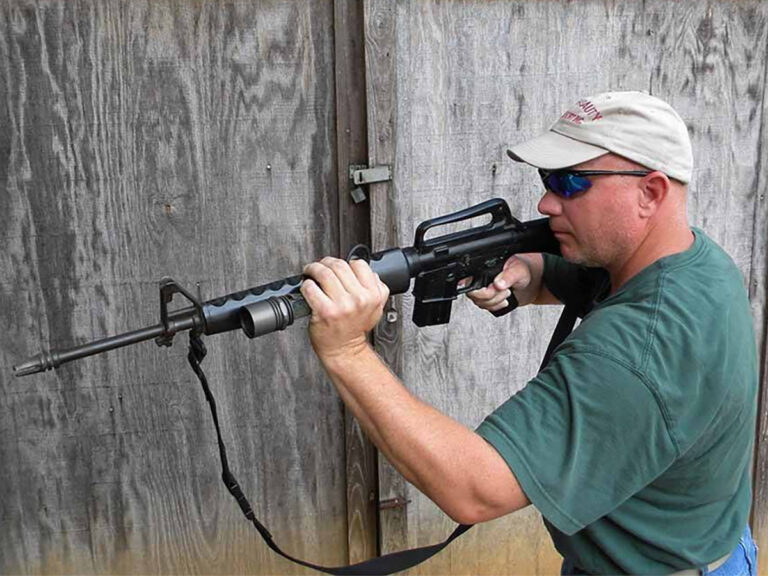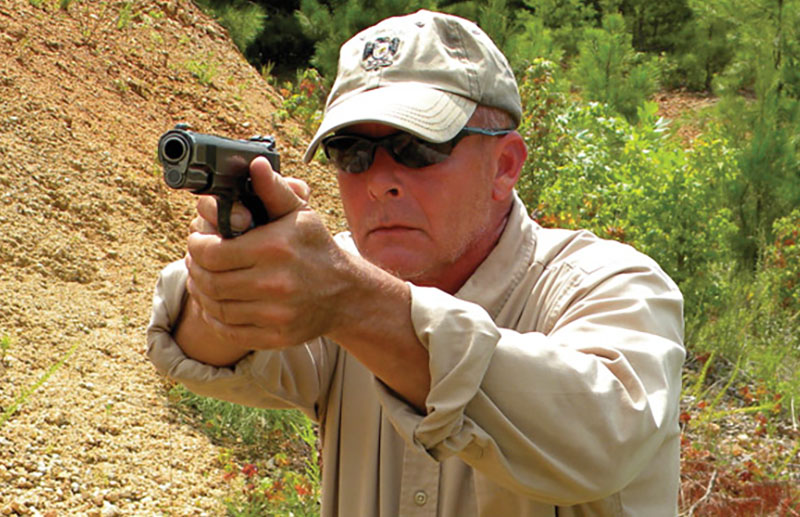
We look back on Tiger McKee’s The Book of Two Guns: The Martial Art of the 1911 Pistol and AR Carbine, a legacy in martial gunfighting.
When the name Tiger McKee is spoken among serious students of firearms, it carries the weight of both reverence and respect. McKee was more than a firearms instructor. He was a martial artist in the truest sense, seeing the pistol and carbine not merely as weapons but as extensions of the individual. His life’s work culminated in The Book of Two Guns: The Martial Art of the 1911 Pistol and AR Carbine, a volume that remains one of the most unique and personal contributions to the world of defensive shooting.
A Teacher’s Journey
McKee founded the Shootrite Firearms Academy in Alabama, where for decades he trained civilians, military and law enforcement in the art of the gun. He was known for a quiet, thoughtful presence that contrasted with the intensity of the subject matter. Those who trained under him remember his insistence that “fighting is 90 percent mental,” a philosophy that emphasized awareness, discipline and preparation as much as marksmanship.
McKee died in 2023, leaving behind not only students but also a body of written work that reflects his unique voice and worldview. At the center of this legacy stands The Book of Two Guns.
The Book as Martial Art
Published in 2005, The Book of Two Guns is unlike any other shooting manual. It’s neither a slick, photo-heavy coffee-table book nor a dry, step-by-step manual buried in military jargon. Instead, McKee wrote it in his own hand—literally. The text is handwritten, and the illustrations are his own sketches. This artistic choice was intentional. McKee sought to communicate that shooting is not a mechanical checklist but a martial art, with parallels to the discipline of swordsmanship or karate.
The two “guns” of the title, the 1911 pistol and the AR-15/M16 carbine, were chosen because they represent the pinnacle of American fighting arms. The 1911, with its century of service, and the AR-15 platform, the standard bearer of modern rifle craft, were to McKee what the katana and the wakizashi were to the samurai: paired tools of a complete warrior.
Principles, Not Techniques
A hallmark of McKee’s philosophy was the emphasis on principles over rote technique. In The Book of Two Guns, he outlines fundamentals such as stance, grip, trigger control and movement, but always returns to the why behind the how.
For example, McKee taught that “accuracy is defined by the shot you are firing.” This deceptively simple line reinforces that each round carries responsibility. Every press of the trigger must be deliberate and purposeful. Likewise, his insistence on consistency, mentally and physically, remains a touchstone for students who learned that success under stress comes from ingrained, repeatable habits.
Unlike traditional manuals, McKee’s book does not attempt to catalog every possible shooting technique. Instead, it presents concepts like movement, cover, avoidance, angles of fire that the practitioner must adapt to circumstances. The result is less an instruction manual than a meditation on combat with the gun.
The 1911 Pistol: A Warrior’s Sidearm
McKee’s choice of the 1911 as one of his “two guns” was deliberate. He believed that the 1911, properly understood and mastered, remained one of the most effective fighting pistols ever designed. In his book, he explores the nuances of grip safety manipulation, trigger discipline, and the balance of accuracy with speed.

But he also approached the 1911 as a martial tool, emphasizing mindset over mechanics. “We shoot to stop the threat, to save life, not take it,” a philosophy he drilled into students at Shootrite and one that resonates throughout the book. This moral framework is one of the reasons McKee’s work continues to inspire. He did not glorify violence. He taught preparation to preserve life.
The AR Carbine: America’s Rifle
The second of the “two guns,” the AR-15/M16 platform, represents adaptability and precision. McKee’s instruction on the AR focused not only on manipulations like loading, clearing malfunctions and transitions but also on tactics. He emphasized the geometry of fighting around cover, the use of light in low-light conditions, and the importance of movement to create advantage.
For McKee, the rifle was more than a tool for distance. It was a partner to the pistol, each complementing the other in the modern martial toolkit. His sketches in the book illustrate not just firing positions, but the flow of a fighter moving through space—always thinking, always adjusting.
My Journey with McKee
I first met McKee in 2012 during his Defensive Handgun course. From the start, his style stood out. He didn’t run flashy drills or bark orders for effect, Instead, he built consistency through repetition. “All guns are always loaded,” he would remind us, before drilling the fundamentals: Aim, hold, press, follow-through.
In later classes like his Pocket Pistol course with moving targets, he emphasized manipulations and tactics: reloads, malfunction clearances, and the mantra of move, communicate, cover, shoot, think. By the time I attended his Low-Light Handgun class in 2016, I had internalized his lesson that fighting is sudden, chaotic and unpredictable. You control only yourself.
Those classes, and the notes I still keep, remain touchstones of his teaching. They remind me that McKee saw the gun as more than steel and polymer—it was a discipline, a martial path.
Training at Shootrite: The Living Book
At Shootrite, students learned the same principles laid out in The Book of Two Guns: accuracy through consistency, movement combined with communication, and the central rule to “move, communicate, use cover whenever possible, shoot as necessary and THINK.”
The overlap between the handwritten words in McKee’s book and the drills on the range made clear that his philosophy was holistic. It was never about tricks or shortcuts. It was about cultivating the mind of a fighter.
Reception and Legacy
When The Book of Two Guns was first released, it quickly gained a reputation as something rare and authentic. Some reviewers described it as more akin to a martial arts manual than a gunfighting book. Others noted that its unpolished, handwritten form made it feel like a personal field notebook—one that belonged in a range bag rather than on a bookshelf.
Over time, the book became a cult classic among trainers, competitive shooters, and tacticians. It is often cited alongside the works of Jeff Cooper and Clint Smith as a cornerstone of modern firearms philosophy.
McKee’s death in 2023 was widely mourned in the firearms community. Obituaries recalled not only his skills as an instructor but also his humility, humor and humanity. He leaves behind a generation of students who carry his lessons forward, whether in uniform, in competition or simply as responsible armed citizens.
Conclusion: A Warrior’s Notebook
The Book of Two Guns is more than a firearms manual. It is McKee’s personal martial notebook. Its handwritten pages invite the reader into his thought process. His sketches reveal his eye for detail, and its principles demand reflection as much as practice.
Whether you train with the classic 1911, the modern AR-15, or some other firearm entirely, this book is full of wisdom on the art of self-defense. It reminds us that the true weapon is the mind, and that discipline, respect and preparation matter more than hardware.
McKee may be gone, but through his teachings and his book, his voice endures. Like the guns he revered, his ideas remain timeless tools—ready to serve those willing to put in the discipline, respect and heart that true martial arts demand.
Editor's Note: This article originally appeared in the December 2025 issue of Gun Digest the Magazine.
More On Shooting Skills:
- Video: Target Transition Training With The Dot Drill
- The Shot Timer And Defensive Handgun Training
- Gun Digest’s 10 Best Shooting Drills And Firearms Training Posts
- MantisX: Simple And Effective Training
- Video: Is A Full-Sized Pistol The Best Training Option?

Next Step: Get your FREE Printable Target Pack
Enhance your shooting precision with our 62 MOA Targets, perfect for rifles and handguns. Crafted in collaboration with Storm Tactical for accuracy and versatility.
Subscribe to the Gun Digest email newsletter and get your downloadable target pack sent straight to your inbox. Stay updated with the latest firearms info in the industry.

![Best Concealed Carry Guns In 2025 [Field Tested] Wilson Combat EDC X9S 1](https://gundigest.com/wp-content/uploads/Wilson-Combat-EDC-X9S-1-324x160.jpg)


![Best 9mm Carbine: Affordable PCCs [Tested] Ruger Carbine Shooting](https://gundigest.com/wp-content/uploads/Ruger-Carbine-Shooting-100x70.jpg)
![Best AR-15: Top Options Available Today [Field Tested] Harrington and Richardson PSA XM177E2 feature](https://gundigest.com/wp-content/uploads/Harrington-and-Richardson-PSA-XM177E2-feature-100x70.jpg)
